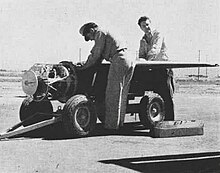Bat (missile)
The Bat (SWOD MK 9 or ASM-N-2) was a radar-guided American glide bomb that was mainly used against ships in the Asian theater of war towards the end of the Second World War.
weapon
The weapon, which was relatively simple compared to today's systems, was equipped with wings and a double tail unit, partly made of wood. When dropped from a bomber, it could carry a warhead weighing around 1,000 pounds over a maximum distance of 20 miles. The flight was gliding without propulsion.
In contrast to German radio-controlled designs, the American weapon controlled itself completely autonomously after being dropped ( Fire and Forget ) based on the radar data from the active radar : the radar transmitter as a receiver was located in the missile itself. Bat was a further development from the discontinued "Pelican" project, which still had a passive radar receiver .
commitment
Bat was completed in 1945 and used in the Asian theater of war. Modified PB4Y-2 Privateer bombers and , in individual cases, fighter planes were used as missile carriers . Various merchant ships and warships were sunk or hit, including a Japanese escort ship in May 1945 at a distance of 32 kilometers (20 miles), which, according to many sources, is the maximum range for this guided missile. Some bombs were used with modified radar seekers against bridges in the Japanese-occupied area.
Around 3,000 missiles were produced, most of which remained in the magazine. The simple logic of the radar seeker construction was already irritated by the proximity to land or nearby ships. Enemy disruptive measures (such as chaff or ECM ) would have made use more difficult. After attempts to further develop the control system in 1948, the weapon was retired after 1950.
Technical specifications
- Span: 3.05 m
- Length: 3.63 m
- Weight: 850 kg (complete)
- Warhead: 450 kg
- Speed: 480 km / h
- Drop distance: 8,000 m
- Range: 32,000 m

